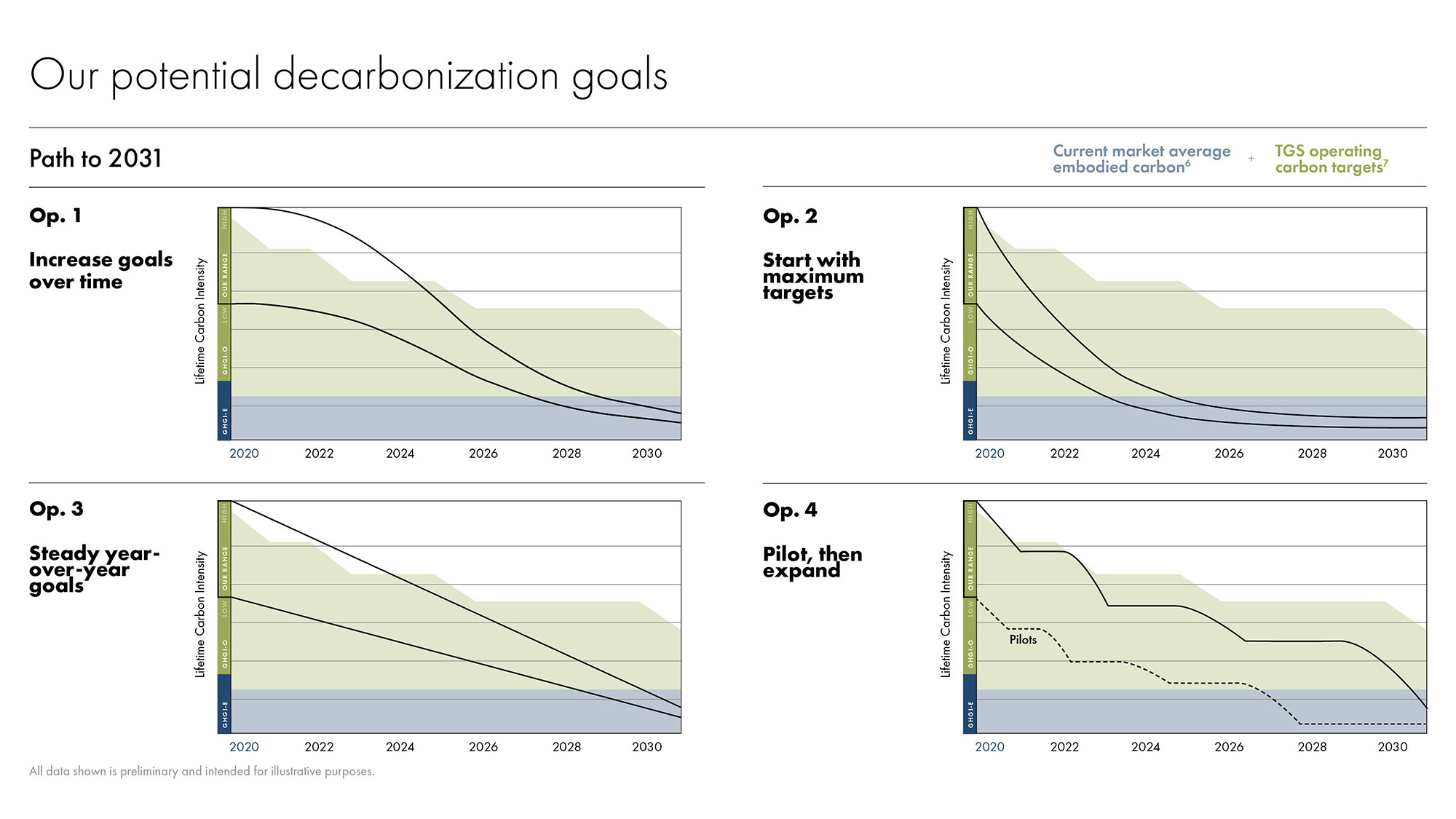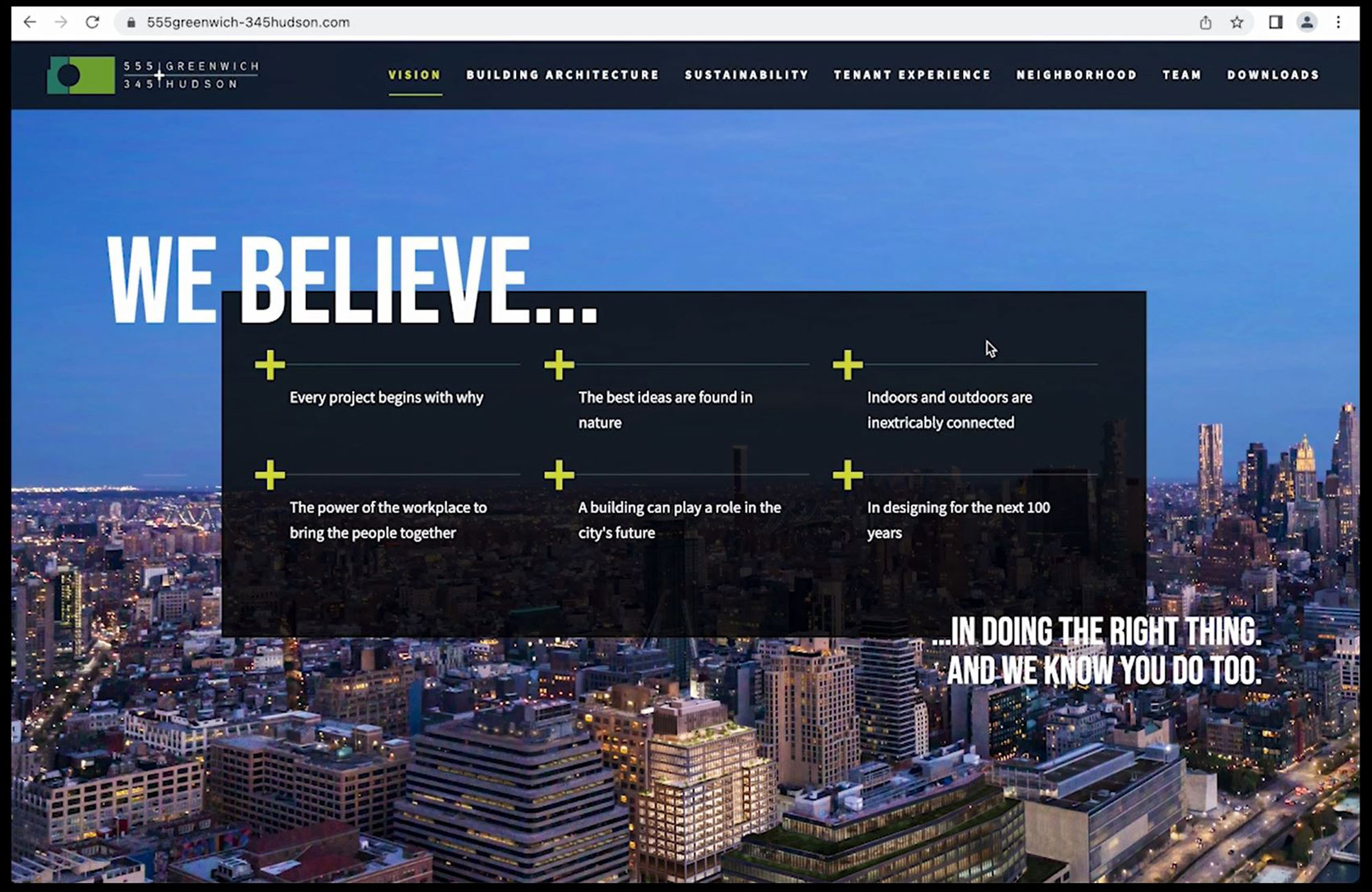4 Powerful Approaches for Putting Climate Goals to Action
April 16, 2024 | By David Briefel, Mallory Taub, Jeremy Shannon, Melissa Kelly, and Joseph Lauro
To bend the curve for mitigating climate change below catastrophic levels, international consensus highlights that the 2020s must be the “decade of action” in which urgent, large-scale climate action is implemented across the global economy. Legislators are attempting to reign in carbon emissions through increasingly stringent regulations in key markets, including new operational carbon limits in New York and Boston, required disclosure of Scope 1, 2, and 3 emissions in California, and new energy and carbon reporting policies in the United Kingdom, among a few examples. Building owners, corporate organizations, and the building industry at large have reached a critical juncture for bringing together organizational strategy with design thinking to drastically reduce carbon emissions in the built environment.
Many large organizations have made fast approaching 2025 and 2030 carbon reduction commitments, and the time is now for strategic planning to define actionable goals with implementable strategies for existing buildings and new construction to produce real carbon savings. Gensler’s work on Google’s St. John’s Terminal in New York, for example, highlights how a company with clearly defined organizational goals for accelerating carbon-free and circular design systems can realize these goals in a specific project site. The project represents an example of targeted sustainable design strategies related to operational and embodied carbon reduction, design for flexibility, and closed-loop construction waste coalescing in a singular site through close collaboration between a client and design teams.
As a real estate business leader or building portfolio manager, you might find yourself wondering how to create and implement a sustainability action plan that defines specific, tangible strategies for buildings that achieve broad, organizational targets. Gensler’s Climate Action studio has identified four approaches that put organizations on a credible path to achieving climate goals as sustainable design becomes more fully integrated into business practices.
1. Create a proactive climate action plan with implementable milestones.
Creating an action plan with tangible steps for implementation can make or break even the most modest climate action goals. For example, the recent EY Global Climate Risk Barometer found a “deep disconnect between organizations’ climate and corporate strategy,” indicating that 47% of companies surveyed do not disclose how they plan to pivot their business model and operations to align with stated climate goals. For many companies, making statements is easy, but turning those statements into actionable plans and putting them into motion remains a confusing and fraught process.
Furthermore, these plans must be crafted with an eye toward each company’s governance capacities. Inadequate internal capacity for management and implementation can limit the ambitions of even the best laid climate action plans. Governance issues may be a clear indicator that a critical first step in implementing climate action plans is to increase governance capacity. After all, implementing climate action plans will likely require significant change management within organizations themselves to bring commitments into reality.
Case Study: The Daniels Corporation Decarbonization PlanWorking with The Daniels Corporation, a Canadian real estate developer, Gensler co-developed a portfolio-wide sustainability roadmap to facilitate ambitious whole life carbon targets across the company’s properties. Gensler conducted a series of stakeholder engagement workshops to build consensus regarding aspirations, market impact, and change management strategy to support progress towards decarbonization goals. Gensler also created a Sustainability Framework document clearly defining carbon targets, intended outcomes, specific paths to achieve the goals, and a data collection methodology to track progress. The targets were informed by an evaluation of a select number of existing projects, along with market analysis and projected trends in sustainable construction.
To ease adoption of the data collection methodology, Gensler created a data collection tool that enables project managers and analysts to track key parameters that drive carbon across the company portfolio, providing a deeper understanding of effective design strategies. Gensler worked with The Daniels Corporation and their project partners to ensure that the data collection tool interface is user-friendly and has built-in quality control without sacrificing data richness.

2. Execute data-driven decisions to maximize impact.
Performance modeling and data tracking are powerful strategies to pursue net zero-carbon goals for single properties, as well as entire global portfolios. Hines reports that “building data can be used to optimize operations, provide a competitive advantage in leasing, and drive occupant satisfaction,” in addition to reducing carbon emissions. When done right, climate scenario modeling can inform actions to drive down operational carbon emissions. Using lifecycle assessment to compare embodied carbon during design and material selection can blunt the carbon intensity of both ground-up and renovation projects. Consistent and complete data leads to a shared understanding of priorities and validates actions.
Gensler’s Climate Action practice worked with Harrison Street, a leading investment management firm exclusively focused on alternative real assets, to develop a white paper exploring the importance of decarbonization for demographic-driven and energy-intensive real estate sectors. Using a data-driven approach, Gensler contextualized hot spots within the portfolio by cross-assessing Harrison Street’s portfolio performance with market- and asset-level benchmarks. The white paper outlines the key data points necessary to inform a deeper understanding of portfolio performance and invites all real estate investment managers to engage with data for effective decision-making. You can read more and download the white paper here.

3. Implement sustainable design standards for consistency in execution.
Individual project teams should not be expected to define how portfolio-scale sustainability targets apply to their site. Establishing one set of sustainability guidelines and tools for all project teams to adopt streamlines progress and amplifies impact by aligning strategies across all sites.

As Gensler strives to meet 2030 climate goals, we developed the Gensler Product Sustainability (GPS) Standards, which define minimum sustainability criteria for high-impact building materials in our projects. The GPS Standards have been integrated into our projects in the U.S., Canada, U.K., and Europe since January 2024. The criteria were developed based on industry norms and in alignment with industry organizations, regulatory standards, and certifications such as Carbon Leadership Forum, mindful MATERIALS, REACH, ISO, BIFMA, LEED, BREEAM, and Living Building Challenge, among others. While the GPS criteria are holistic across life-cycle impacts, material health and transparency, and indoor air impacts, the inclusion of embodied carbon requirements and targets specifically contribute to our clients’ climate impact goals, in addition to our own commitments.
4. Represent sustainability commitments in built spaces to communicate values.
Recent changes in the office market across have set off a “flight to quality” among tenants looking to lock in high quality office spaces while making progress toward achieving climate goals. Amid this context, landlords who can effectively communicate their sustainability commitments can differentiate their properties from the competition. JLL reports that “demand for high quality, low-carbon workspace is set to outstrip supply by 75%, across major U.S. markets by 2030.” Translating these commitments for users and the public can help communicate company values and culture in significant ways.

Gensler worked with Hines’ sustainability team to develop clear visual and web-based graphics that help explain the building’s complex resilience features in a clean, easy-to-understand way that focuses on the experiential benefits to the end user. The team developed graphic and branding approaches in collaboration with the client to communicate the market leading sustainable design strategies that drive the project. Beyond the LEED Platinum certification achieved by the base building design team led by COOKFOX, the branding campaign communicates sustainability by clearly quantifying and celebrating meaningful achievements — an important factor for attracting tenants.
As organizations mobilize during this decade of action, setting clear strategic plans supported by an approach to measurement and accountability will be critical for achieving progress. Key ingredients for success include consistently implementing sustainable design standards and crafting clear, visual communications that effectively communicate progress. When executed with rigor, proper planning, and accountability, strategic climate action plans can produce tangible progress toward organizational climate goals so organizations can actualize their sustainability commitments and accelerate climate action for the built environment.
Contact us to begin a conversation about how these strategic services can support your organization now and into the future.

For media inquiries, email .





